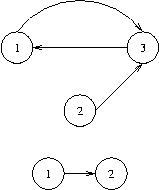The Bottom of a Graph
| Time Limit: 3000MS | Memory Limit: 65536K | |
| Total Submissions: 7098 | Accepted: 2905 |
Description
We will use the following (standard) definitions from graph theory. Let
V be a nonempty and finite set, its elements being called vertices (or nodes). Let
E be a subset of the Cartesian product V×V, its elements being called edges. Then
G=(V,E) is called a directed graph.
Let n be a positive integer, and let p=(e1,...,en) be a sequence of length n of edges ei∈E such that ei=(vi,vi+1) for a sequence of vertices (v1,...,vn+1). Then p is called a path from vertex v1 to vertex vn+1 in G and we say that vn+1 is reachable from v1, writing (v1→vn+1).
Here are some new definitions. A node v in a graph G=(V,E) is called a sink, if for every node w in G that is reachable from v, v is also reachable from w. The bottom of a graph is the subset of all nodes that are sinks, i.e., bottom(G)={v∈V|∀w∈V:(v→w)⇒(w→v)}. You have to calculate the bottom of certain graphs.
Let n be a positive integer, and let p=(e1,...,en) be a sequence of length n of edges ei∈E such that ei=(vi,vi+1) for a sequence of vertices (v1,...,vn+1). Then p is called a path from vertex v1 to vertex vn+1 in G and we say that vn+1 is reachable from v1, writing (v1→vn+1).
Here are some new definitions. A node v in a graph G=(V,E) is called a sink, if for every node w in G that is reachable from v, v is also reachable from w. The bottom of a graph is the subset of all nodes that are sinks, i.e., bottom(G)={v∈V|∀w∈V:(v→w)⇒(w→v)}. You have to calculate the bottom of certain graphs.
Input
The input contains several test cases, each of which corresponds to a directed graph
G. Each test case starts with an integer number v, denoting the number of vertices of
G=(V,E), where the vertices will be identified by the integer numbers in the set
V={1,...,v}. You may assume that 1<=v<=5000. That is followed by a non-negative integer
e and, thereafter, e pairs of vertex identifiers v1,w1,...,ve,we with the meaning that
(vi,wi)∈E. There are no edges other than specified by these pairs. The last test case is followed by a zero.
Output
For each test case output the bottom of the specified graph on a single line. To this end, print the numbers of all nodes that are sinks in sorted order separated by a single space character. If the bottom is empty, print an empty
line. ![]()

Sample Input
3 3 1 3 2 3 3 1 2 1 1 2 0
Sample Output
1 3 2 找出度为零的强连通分量,把符合条件的点都输出出来。
#include<stdio.h> #include<string.h> #include<vector> #include<stack> using namespace std; vector<int> vec[5005]; stack<int> sta; int dfn[5005],low[5005]; int vis[5005]; int gro_id[5005],gro[5005]; int now,id; int n,m; void tarjan(int s) { now++; vis[s]=2; dfn[s]=low[s]=now; sta.push(s); for(int i=0; i<vec[s].size(); i++) { if(vis[vec[s][i]]==0) { tarjan(vec[s][i]); low[s]=low[s]<low[vec[s][i]]?low[s]:low[vec[s][i]]; } else if(vis[vec[s][i]]==2) low[s]=low[s]<dfn[vec[s][i]]?low[s]:dfn[vec[s][i]]; } if(low[s]==dfn[s]) { id++; while(1) { int t=sta.top(); gro_id[t]=id; vis[t]=1; sta.pop(); gro[id]++; if(t==s) break; } } } int main() { while(scanf("%d",&n)&&n!=0) { now=id=0; scanf("%d",&m); //printf("123\n"); memset(dfn,0,sizeof(dfn)); memset(low,0,sizeof(low)); memset(vis,0,sizeof(vis)); memset(gro_id,0,sizeof(gro_id)); memset(gro,0,sizeof(gro)); //printf("123\n"); for(int i=1; i<=n; i++) vec[i].clear(); for(int i=0; i<m; i++) { int a,b; scanf("%d%d",&a,&b); vec[a].push_back(b); } //printf("123\n"); for(int i=1; i<=n; i++) if(!vis[i]) tarjan(i); //printf("123\n"); memset(vis,0,sizeof(vis)); int s=0; for(int i=1; i<=n; i++) for(int j=0; j<vec[i].size(); j++) if(gro_id[i]!=gro_id[vec[i][j]]) { if(vis[gro_id[i]]==0) s++; vis[gro_id[i]]=1; } if(s!=id) { for(int i=1; i<=n; i++) { if(vis[gro_id[i]]==0) printf("%d ",i); } } printf("\n"); } return 0; }
作者:a451907 发表于2013-1-26 19:17:00 原文链接
阅读:74 评论:1 查看评论